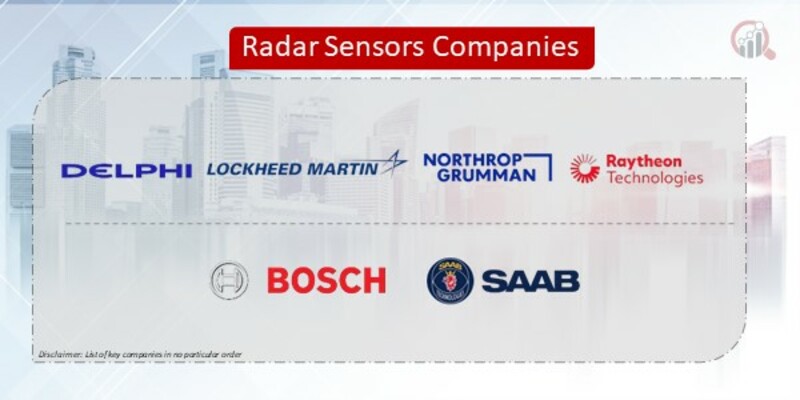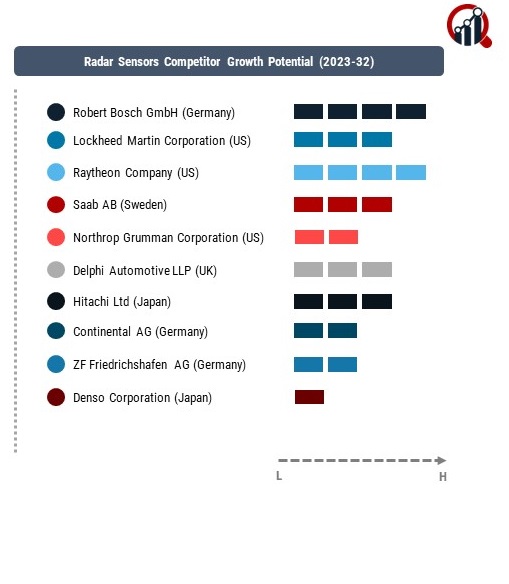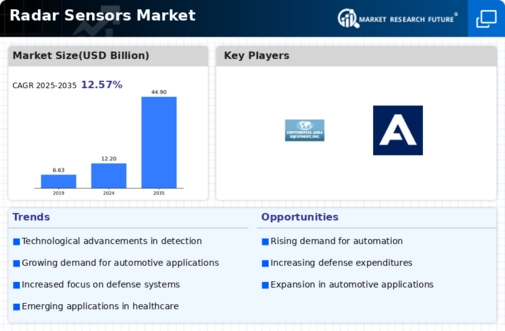Top Industry Leaders in the Radar Sensors Market

Strategies Adopted: In the fiercely competitive Radar Sensors market, key players deploy strategic approaches to maintain a competitive edge. Continuous investment in research and development (R&D) is paramount, enabling companies to introduce next-generation radar sensors with enhanced detection capabilities, range, and accuracy. Strategic collaborations with defense organizations, automotive manufacturers, and technology partners facilitate the development of specialized radar solutions tailored to specific applications. Global market expansion is achieved through participation in defense contracts, partnerships with original equipment manufacturers (OEMs), and establishing a strong presence in emerging markets, ensuring a broad market reach and allowing companies to address diverse industry needs worldwide.
Competitive Landscape of Radar Sensors Market
- Robert Bosch GmbH (Germany)
- Lockheed Martin Corporation (US)
- Raytheon Company (US)
- Saab AB (Sweden)
- Northrop Grumman Corporation (US)
- Delphi Automotive LLP (UK)
- Hitachi Ltd (Japan)
- Continental AG (Germany)
- ZF Friedrichshafen AG (Germany)
- Denso Corporation (Japan)
- Infineon Technologies AG (Germany)
- NXP Semiconductors NV (Netherlands)
- Omniradar BV (Netherlands)
- Airbus Group (Netherlands)
Factors for Market Share Analysis: Market share analysis in the Radar Sensors market involves considering various factors crucial to a company's competitive standing. Technical capabilities, such as offering a comprehensive range of radar sensors covering different frequency bands, applications, and industries, play a pivotal role. Companies providing adaptable and customizable radar solutions capable of addressing diverse market requirements are better positioned to capture a larger market share. Compliance with stringent industry standards, the integration of advanced signal processing algorithms, and the ability to offer radar sensors with high resolution contribute significantly to market share dynamics. Additionally, factors like power consumption, size, and overall cost-effectiveness influence a company's market share by enhancing the overall value proposition for industries seeking reliable and efficient radar sensing solutions.
New and Emerging Companies: While established players dominate the market, new and emerging companies are entering the Radar Sensors sector, contributing to innovation and market diversification. Companies like Ainstein, Quanergy Systems, and Metawave Corporation are gaining recognition for their specialized radar sensors, often focusing on novel radar technologies, such as millimeter-wave radar and phased-array radar, and addressing applications like autonomous vehicles and industrial automation. Emerging companies often bring agility and a fresh perspective to the Radar Sensors market, introducing novel approaches and technologies that cater to the evolving demands of modern industries.
Industry News: Recent industry news in the Radar Sensors market underscores ongoing developments and trends shaping the sector. Innovations in automotive radar for advanced driver assistance systems (ADAS), advancements in radar technology for aerospace and defense applications, and the integration of radar sensors with artificial intelligence (AI) for improved object recognition are gaining prominence. News often covers developments in the deployment of radar sensors for smart cities, weather monitoring, and industrial automation. Additionally, the market is witnessing news related to the introduction of radar sensors with higher frequency bands for enhanced resolution and improvements in radar sensor packaging for compact and robust designs. Industry news reflects the dynamic nature of the Radar Sensors market, with continuous efforts to improve sensing capabilities, versatility, and overall efficiency.
Current Company Investment Trends: Investment trends in the Radar Sensors market underscore a commitment to technological innovation, miniaturization, and global market reach. Companies are allocating substantial resources to R&D initiatives focused on radar sensor technologies, including advanced antenna designs, beamforming techniques, and integration with complementary sensor technologies like lidar and cameras. Investments in sustainability practices, including the development of radar sensors with lower power consumption and environmentally friendly materials, align with the broader environmental goals of the technology industry. Strategic acquisitions of technology startups specializing in radar sensor applications, partnerships with research institutions, and collaborations with international industry consortia contribute to a comprehensive approach, ensuring a continuous stream of cutting-edge solutions and maintaining a competitive stance in the market.
Overall Competitive Scenario: The overall competitive scenario in the Radar Sensors market reflects a balance between established industry leaders and emerging companies that bring innovation and flexibility to the sector. Established radar technology providers leverage their extensive experience, global reach, and comprehensive radar sensor portfolios to set industry standards. Simultaneously, emerging companies contribute to the diversification of Radar Sensors solutions, often focusing on specific applications or introducing disruptive radar technologies. The industry's response to evolving market demands, technological advancements, and the integration of advanced features into radar sensors highlights the adaptability and resilience of Radar Sensors providers. As industries globally seek more advanced, efficient, and versatile sensing solutions, the Radar Sensors market is poised for continued evolution. The emphasis on technological advancements, strategic collaborations, and meeting the dynamic needs of modern applications positions this market as a critical enabler for enhancing sensing capabilities across various industries, including defense, automotive, and industrial automation.
Recent Development:
December 2022, the Indy Autonomous Challenge (IAC) secured exclusive support from Continental, a prominent technology company. This expansive collaborative initiative brings together public-private partnerships and academic institutions to collaborate on the design, construction, and demonstration of a new era of automated vehicle software, specifically for fully autonomous race cars. Continental is contributing its ARS540 4D imaging radar sensors to the project, granting access for use in the Dallara AV-21—the world's fastest autonomous racecar and capable of highly automated driving.
February 2022, NXP Semiconductor announced a significant milestone in partnership with innovative micro, wherein they developed a 4D imaging radar sensor. This sensor incorporates NXP's 6th generation flagship radar processor S32R45 and integrates four TEF8232 transceivers, offering a total of 192 virtual channels. The result is an impressive angular resolution of one degree at distances up to 300 meters.
January 2022, DENSO, a leading mobility supplier, introduced the Global Safety Package—an active safety system crafted to enhance vehicle safety through heightened sensing capabilities. This safety package combines the performance of a vision sensor and a millimeter-wave radar sensor, assisting the driver in safely controlling the vehicle.










